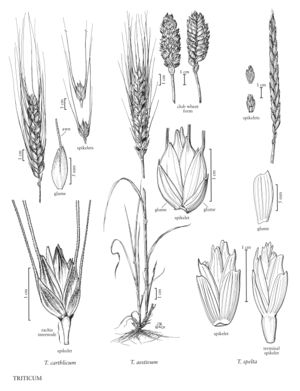Difference between revisions of "Triticum spelta"
FNA>Volume Importer |
FNA>Volume Importer |
||
| Line 17: | Line 17: | ||
-->{{Treatment/Body | -->{{Treatment/Body | ||
|distribution=Ky.;Vt. | |distribution=Ky.;Vt. | ||
| − | |discussion=<p>In the Flora region, Triticum spelta is grown for the specialty food and feed grain markets. It is known for yielding a pastry-grade flour not suitable for bread making unless mixed with T. aestivum, the bread-quality flour. Modern plant breeding programs are improving its gluten profile to upgrade its bread-making quality. Consequently, claims that T. spelta is a safe option for consumers with gluten intolerance should be treated with caution.</p><!-- | + | |discussion=<p>In the Flora region, <i>Triticum spelta</i> is grown for the specialty food and feed grain markets. It is known for yielding a pastry-grade flour not suitable for bread making unless mixed with <i>T. aestivum</i>, the bread-quality flour. Modern plant breeding programs are improving its gluten profile to upgrade its bread-making quality. Consequently, claims that <i>T. spelta</i> is a safe option for consumers with gluten intolerance should be treated with caution.</p><!-- |
| − | --><p>The ability of Triticum spelta to break under pressure into barrel-shaped units similar to those found in Aegilops cylindrica distinguishes it from all other members of Triticum.</p> | + | --><p>The ability of <i>Triticum spelta</i> to break under pressure into barrel-shaped units similar to those found in <i>Aegilops cylindrica</i> distinguishes it from all other members of <i>Triticum</i>.</p> |
|tables= | |tables= | ||
|references= | |references= | ||
| Line 39: | Line 39: | ||
|publication year= | |publication year= | ||
|special status= | |special status= | ||
| − | |source xml=https://jpend@bitbucket.org/aafc-mbb/fna-data-curation.git/src/ | + | |source xml=https://jpend@bitbucket.org/aafc-mbb/fna-data-curation.git/src/8f726806613d60c220dc4493de13607dd3150896/coarse_grained_fna_xml/V24/V24_395.xml |
|subfamily=Poaceae subfam. Pooideae | |subfamily=Poaceae subfam. Pooideae | ||
|tribe=Poaceae tribe Triticeae | |tribe=Poaceae tribe Triticeae | ||
Revision as of 16:19, 18 September 2019
Culms 80-120 cm; nodes glabrous or pubescent; internodes hollow, even immediately below the spikes. Blades 12-20 mm wide, sparsely pubescent. Spikes 6-20 cm, about as wide as thick, slender, almost cylindrical, narrowing distally; rachises glabrous or sparsely hairy at the nodes and margins, disarticulating with pressure, disarticulation units barrel-shaped or wedge-shaped. Spikelets 12-16 mm, with 3-5 florets, 1-3 seed-forming. Glumes 5-10 mm, coriaceous, tightly appressed to the lower florets, truncate, with 1 prominent keel, keel winged to the base, terminating in a tooth; lemmas 8-12 mm, toothed or awned, awns on the lower 2 lemmas to 10 cm, the third lemma sometimes awned, awns to 2 cm; paleas not splitting at maturity. Endosperm usually flinty. Haplomes AuBD. 2n = 42.
Discussion
In the Flora region, Triticum spelta is grown for the specialty food and feed grain markets. It is known for yielding a pastry-grade flour not suitable for bread making unless mixed with T. aestivum, the bread-quality flour. Modern plant breeding programs are improving its gluten profile to upgrade its bread-making quality. Consequently, claims that T. spelta is a safe option for consumers with gluten intolerance should be treated with caution.
The ability of Triticum spelta to break under pressure into barrel-shaped units similar to those found in Aegilops cylindrica distinguishes it from all other members of Triticum.
Selected References
None.
